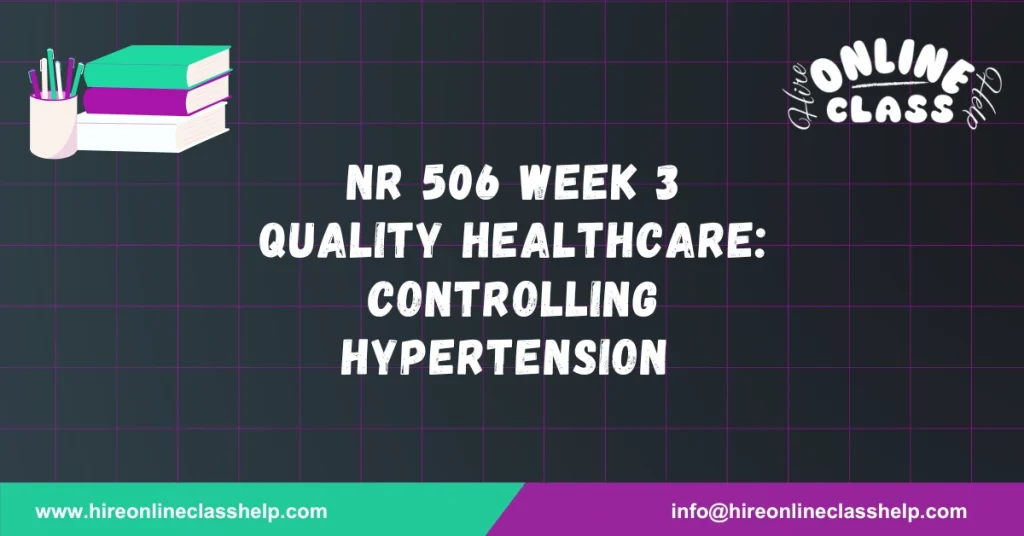






Name
Chamberlain University
NR-506: Healthcare Policy
Prof. Name
Date
Hypertension is one of the most critical health challenges in the United States, being a major contributor to heart disease, stroke, and premature mortality. Uncontrolled high blood pressure is considered a “silent killer” because patients often remain asymptomatic until complications occur. Recognizing this, the National Committee for Quality Assurance (NCQA) includes hypertension as part of the Healthcare Effectiveness Data and Information Set (HEDIS) under the effectiveness of care domain (NCQA, 2020).
Efforts to manage hypertension require comprehensive strategies involving both healthcare providers and patients. Family Nurse Practitioners (FNPs), as primary care leaders, play a pivotal role in implementing interventions, measuring outcomes, and guiding patients toward healthier lifestyles. Effective patient-centered interventions not only improve health outcomes but also reduce healthcare costs and enhance overall satisfaction.
Patients with hypertension must actively participate in their treatment to achieve long-term success. In the U.S., nearly 30% of adults live with hypertension, while globally, more than one billion individuals are affected (Liyanage-Don, Fung, Phillips, & Kronish, 2019). Encouraging lifestyle changes and self-management strategies empowers patients to take control of their health.
Three effective interventions that help patients control hypertension include:
Home blood pressure monitoring and logging
Adopting a heart-healthy diet
Increasing physical activity
These strategies can be reinforced by FNPs through education, regular follow-ups, and personalized care plans.
Patient Interventions for Controlling Hypertension
| Intervention | Description | Expected Outcome | Supporting Evidence |
|---|---|---|---|
| Home Blood Pressure Monitoring | Patients measure BP at home and maintain logs to track daily fluctuations. | Helps identify “white coat hypertension,” ensures accurate data, and allows timely medication adjustments. | Liyanage-Don et al. (2019) |
| Heart-Healthy Diet | Reduce sodium, processed meat, and sugar; increase fruits, vegetables, and omega-3 fatty acids. | Lowers systolic and diastolic pressure; prevents obesity and cardiovascular disease. | Dinu, Pagliai, & Sofi (2017) |
| Regular Exercise | Engage in moderate-intensity aerobic activity (30 min, 5 days/week). | Reduces weight, lowers BP, improves cardiovascular endurance. | Deka, Pozehl, Williams, & Yates (2017); Kristanti & Prihartono (2019) |
FNPs can utilize both self-reported and performance-based measures to evaluate intervention effectiveness.
Self-Reported Outcomes: Patients provide feedback through diet journals, exercise logs, or descriptions of adherence to lifestyle modifications. Subjective data such as perceived energy levels or ease of diet compliance are valuable.
Performance-Based Measures: Objective outcomes such as blood pressure readings, BMI reduction, and improved exercise tolerance provide quantifiable data.
Tools for Measuring Patient Outcomes
| Measurement Tool | Patient Role | NP Role | Benefit |
|---|---|---|---|
| Blood Pressure Logs | Record BP daily at home | Review trends and adjust medications | Detects patterns, avoids misdiagnosis |
| Food Journals | Document diet intake | Assess adherence, refer to nutritionists | Identifies dietary gaps, ensures compliance |
| Exercise Tolerance Tests | Perform gradual activity | Monitor endurance and progress | Shows physical improvement over time |
Close monitoring enables FNPs to adjust treatment promptly, remove barriers to adherence, and educate patients on sustainable lifestyle changes (Blumenthal et al., 2017).
Patient-centered interventions improve health outcomes while reducing overall healthcare costs. Educating patients to self-monitor, eat healthily, and exercise regularly helps prevent complications like stroke or heart failure, which are costly to treat.
FNPs often integrate the Institute for Healthcare Improvement’s Triple Aim Framework, which focuses on:
Enhancing patient experience.
Improving population health.
Reducing per capita healthcare costs (Verma & Bhatia, 2016).
When patients manage their hypertension effectively, unnecessary hospital admissions and frequent unscheduled visits decline. This not only saves patients money but also reduces the burden on clinics, allowing providers to serve more patients efficiently.
Patient satisfaction and positive clinical outcomes are closely linked. Medicare and insurance providers increasingly consider patient satisfaction when determining reimbursement levels (Lindsay, 2017).
Interventions that involve patients in decision-making increase autonomy, adherence, and trust in providers. For example, when patients feel that their provider has empowered them with the tools to control hypertension at home, they are more satisfied and likely to recommend the practice.
Controlling hypertension requires a collaborative effort between patients and providers. By focusing on home blood pressure monitoring, dietary improvements, and exercise, patients can significantly reduce their risk of complications. FNPs serve as facilitators by measuring progress through both subjective and objective outcomes, ensuring tailored care.
These interventions not only improve patient health and quality of life but also contribute to cost savings and enhanced satisfaction. Ultimately, empowering patients to take responsibility for their condition transforms the management of hypertension from a clinical task into a sustainable lifestyle change.
Blumenthal, J. A., Sherwood, A., Smith, P. J., Mabe, S., Watkins, L., Lin, P., … Hinderliter, A. (2015). Lifestyle modification for resistant hypertension: The TRIUMPH randomized clinical trial. American Heart Journal, 170(5), 986–994. https://doi.org/10.1016/j.ahj.2015.08.006
Deka, P., Pozehl, B., Williams, M. A., & Yates, B. (2017). Adherence to recommended exercise guidelines in patients with heart failure. Heart Failure Reviews, 22(1), 41–53.
Dinu, M., Pagliai, G., & Sofi, F. (2017). A heart-healthy diet for hypertension prevention and control. Nutrients, 9(9), 1060. https://doi.org/10.3390/nu9091060
Kristanti, D., & Prihartono, N. (2019). Obesity as a predictor of hypertension in adult population: A 14-years retrospective cohort study. Indian Journal of Public Health Research & Development, 10(6), 491–497.
Lindsay, R. W. (2017). Linking reimbursement to patient satisfaction: Is the tail wagging the dog? JAMA Facial Plastic Surgery, 19(3), 173–174.
Liyanage-Don, N., Fung, D., Phillips, E., & Kronish, I. M. (2019). Implementing home blood pressure monitoring into clinical practice. Current Hypertension Reports, 21(2), 14.
National Committee for Quality Assurance. (2020). HEDIS measures. Retrieved from http://www.ncqa.org/hedis/measures/
Verma, A., & Bhatia, S. (2016). A policy framework for health systems to promote triple aim innovations. HealthCarePapers, 15(3), 9–23.